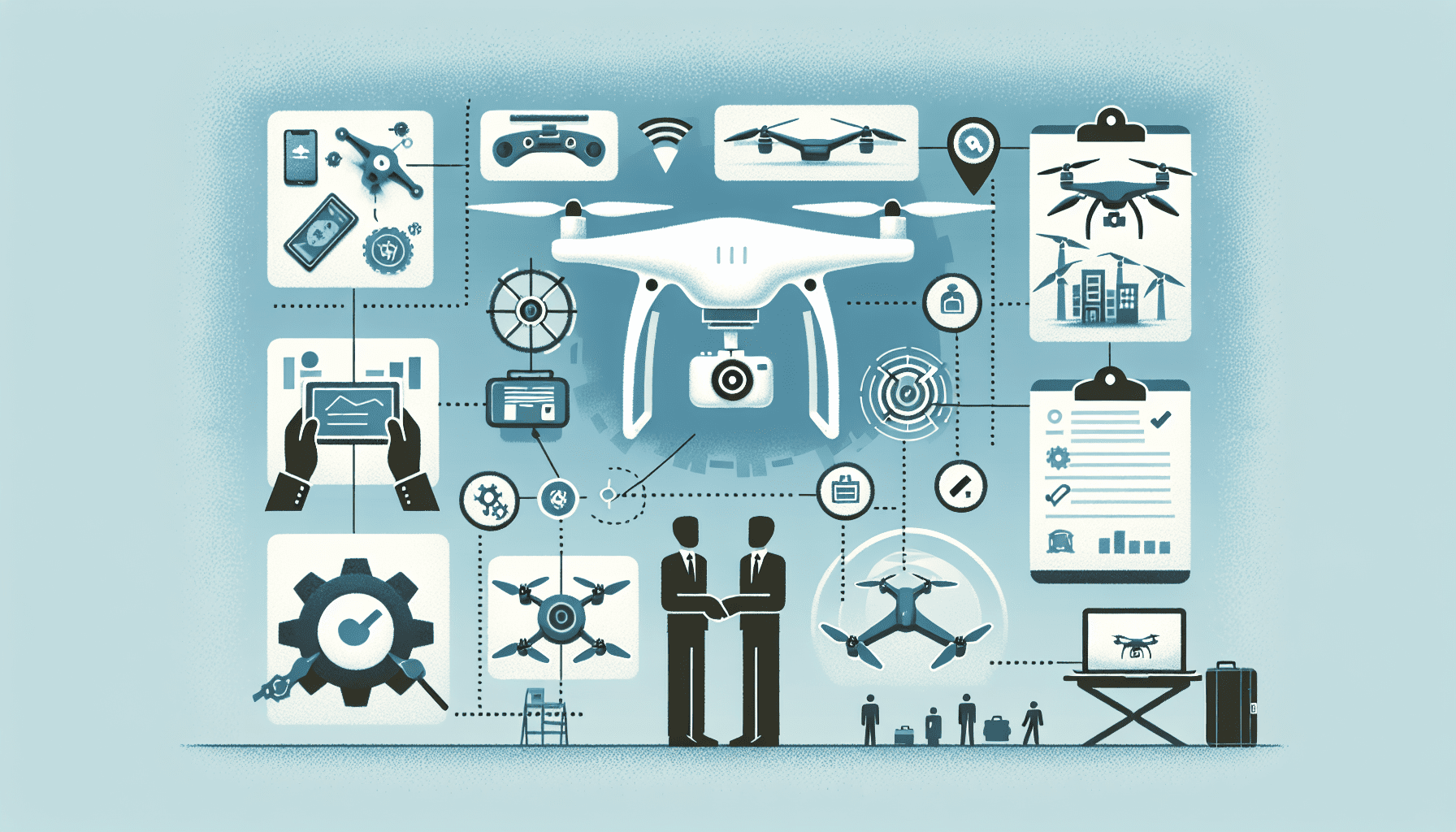Drone Selection Guide for Business Owners in 2024
In This Article
- Align drone selection with specific business needs and industries.
- Evaluate UAV features like battery life, payload, and camera resolution critically.
- Consider ROI beyond purchase cost by factoring in productivity and long-term gains.
- Ensure drones meet regulatory and insurance requirements in your operating region.
- Incorporate data security, navigation intelligence, and SOPs as part of total planning.
- Test drones through pilots or leases before committing to a full rollout.
- Selecting the right drone is a business enabler, not just a tech upgrade.
Understanding the Business Need for Drones
Why Companies Are Investing in Drones
Drone selection has become a critical consideration for enterprises across a variety of sectors. As businesses increasingly embrace digital transformation, the demand for aerial innovation is surging. Whether used for data collection, asset monitoring or streamlined logistics, drones now play a crucial role in improving operational efficiency. For instance, agricultural firms leverage drones for crop analysis, while construction companies use them to assess project progress. The return on investment for drones is compelling—reducing man-hours, enhancing decision-making, and improving safety standards significantly.
The evolution of drone technology has further propelled their uptake. Enhanced battery life, advanced camera systems, real-time connectivity, and software integrations make them indispensable tools rather than futuristic gimmicks. Moreover, the scalability offered through modern unmanned aerial vehicles (UAVs) allows businesses to expand operations without proportionate increases in labour costs. This cost-to-benefit ratio forms the cornerstone of strategic drone selection for many organisations aiming to maintain competitive edges within their industries.

Popular Commercial Drone Applications
Inspection, Delivery, Mapping & More
One of the key drivers behind drone selection is application fit. Businesses utilise drones in multiple operational capacities, and the intended use dictates the type of UAV required. In construction, drones offer aerial progress reports, enabling real-time project management. In the energy sector, specifically wind and solar farms, drones assist in infrastructure inspections, thereby avoiding risky manual checks. Similarly, telecom companies use them to inspect towers and relay stations, minimising downtime and reducing operative hazards.
Retailers and logistics brands are exploring delivery drones to overcome last-mile challenges. Companies like Amazon have been experimenting with autonomous drones to shorten delivery times and lower shipping costs. Agricultural firms continue to use drones to identify irrigation issues, spot disease outbreaks, and optimise pesticide use by analysing multi-spectral data from crops. Those in surveying and real estate employ drones to create 3D terrain maps and dynamic property visuals, adding value to client presentations.
Ultimately, drone selection must align with the desired outcome. Without clearly identified business objectives, companies risk overinvesting in capabilities they do not need or underinvesting in critical features that would maximise drone utility.
“Drone use is no longer a novelty—it’s a necessity for companies seeking smarter, safer, and more scalable operations.”
Evaluating Drone Features for Business Use
When undertaking professional drone selection, businesses must evaluate specific UAV features through the lens of utility and long-term value. Camera quality remains a predominant factor, especially for industries reliant on high-resolution imagery such as real estate, surveying, and landscape architecture. A minimum 4K camera with stabilisation capabilities and zoom functions is often recommended. For agricultural or environmental use, thermal and multispectral imaging expand the scope of aerial data analytics significantly.
Flight time, range, and battery life also warrant close scrutiny. Shorter battery life translates into reduced mission durations and increased downtime. Commercial drones should ideally support 30-60 minutes of continuous flight to be operationally viable. Moreover, payload capacity must be examined, especially for logistics companies or agencies requiring additional sensors or equipment on board.
Altitude hold, obstacle avoidance, and GPS-based navigation systems are crucial for automated tasks and compliance with airspace regulations. Integration capabilities with enterprise software—such as GIS platforms, asset management systems or custom APIs—should also guide drone selection decisions. For teams managing fleets, features like remote monitoring, mission programming, and real-time data uploads streamline coordination and enhance efficiency.
Comparing Top Drones Like Aero 1 Lite and Aero3 LITE
Among the many drones available today, models like the Aero 1 Lite and Aero3 LITE often top the list for commercial procurement. The Aero 1 Lite is suitable for small to medium-sized businesses just entering the drone space. It offers a 40-minute flight time, 4K video capture, real-time cloud sync, and comprehensive obstacle detection. This makes it ideal for real estate, construction and media applications.
In contrast, the Aero3 LITE positions itself as a more robust and enterprise-level solution. With a 55-minute flight duration, dual-camera system (including infrared for thermal inspections), and advanced AI-assisted flight paths, it’s built for complex surveying and utility work. Its payload modularity is unmatched, enabling businesses to swap out components based on mission requirements. For those in agriculture or energy sectors, this flexibility makes the Aero3 LITE a superior investment.
Your drone selection shouldn’t be brand-driven alone; it’s about matching operational priorities to capability sets. Pilot experience level, integration with back-end systems, and future-proof adaptability are all equally important in making a sound technological investment.
Assessing ROI and Operational Costs
Drone selection should not ignore financial considerations. Upfront purchase costs are only a fraction of the total ownership equation. Factors such as maintenance, battery replacement cycles, training for operators, software subscriptions, and potential downtime must be incorporated into cost forecasting. For example, while a premium drone might cost significantly more initially, its reliability, feature set and reduced maintenance may result in a lower total cost of ownership over time.
Moreover, drones produce a cascade of downstream savings. Routine machine inspections in manufacturing facilities, once requiring scaffolding and man-hours, can now be done within minutes using drones—resulting in direct labour savings and indirect productivity gains. Agricultural drones often demonstrate return on investment within their first crop cycle thanks to optimised yields and fewer crop losses.
Learning to quantify these returns—through metrics such as increased speed of data acquisition, lower insurance premiums due to fewer worker injuries, or customer satisfaction improvements from speedier service—is essential for any ROI evaluation strategy in drone selection.
Commercial Drone Laws & Licensing
Compliance is central to responsible drone selection. In the UK, the Civil Aviation Authority (CAA) governs drone usage. Companies operating commercial drones must register their drones and obtain an Operational Authorisation under the Specific Category if their operations aren’t covered by the Open Category permissions. Operators must also complete certification programs such as the General Visual Line of Sight Certificate (GVC).
Additionally, compliance with airspace restrictions, data protection laws (especially when capturing images or video of individuals), and flight altitude limitations is mandatory. Fines for non-compliance can be substantial. Thus, part of any strategic drone selection involves assessing models that are compliant by design—offering features like Geo-fencing, return-to-home safety protocols, and comprehensive flight logs to support governability and auditing.
Companies should also consider using a centralised platform for maintaining flight records and pilot logs, integrating safety checklists, and performing regular audits. Staying ahead of changing regulatory landscapes is vital; drone laws continue to evolve alongside technology and risk dynamics.
The Role of Insurance in Business Drone Usage
Insuring corporate drone operations is not just advisable—it is often legally mandated. In the UK and most of Europe, commercial drone use requires third-party liability coverage under EC regulation 785/2004. The drone selection process should account for insurability. Certain drone models may attract lower insurance premiums due to enhanced safety features, while others might require higher coverage due to increased payloads and airspace complexity.
Specialist drone insurance policies can cover theft, loss, operator error, and damages. Additionally, public liability and professional indemnity coverage may be wise for businesses offering aerial services to clients. Consulting with insurance providers early in the drone selection process allows for more complete visibility into total operation costs and legal exposure mitigation strategies.
Smart Navigation & Data Security in Modern Drones
With cyber threats escalating, data security is no longer optional; it’s a decisive factor in drone selection. Modern drones can store and transmit sensitive business data, including proprietary mapping, inspection footage and customer data. Secure data encryption, onboard storage protections, interval data backups, and GDPR-compliant data handling practices should be high on any procurement checklist.
Navigation systems must also meet modern expectations. Smart route plotting, object avoidance via LiDAR or computer vision, and AI-assisted course corrections enhance efficiency and mitigate accidents. Choosing drones with secure firmware that support periodic updates can prove critical to preventing new vulnerabilities from emerging.
When choosing suppliers, it is also important to factor in the geopolitical considerations of software provenance. Using a supplier subject to questionable data handling legislation abroad could expose your enterprise to undue risk. Open communication with vendors about their cyber protocols is imperative.
Matching Drone Choice to Your Industry
Strategic drone selection starts with sector alignment. For construction firms, drone durability and mapping capabilities are essential. Models equipped with photogrammetry software and terrain modelling integrations should top the list. For mining or biomass industries, thermal imaging and long-range control systems are critical due to remote site operations.
Media, film and photography sectors will focus on 6K cameras, multi-gimbal stabilisers and cinematic flight modes. In contrast, logistics companies prioritise payload capacity and air traffic compliance. For insurers and surveyors, accuracy, flight repeatability and GIS data integrations are paramount. Learn more about Business Drone Buying Guide provides detailed examples of use-case to UAV matching across industries.
No matter the domain, developing a use-case matrix—listing must-have, optional and luxury features—simplifies decision-making and ensures ROI-focused procurement.
Next Steps: Choosing and Purchasing Your Drone
Once a business has identified its needs, legal obligations, and budget constraints, a methodical approach to purchasing is recommended. Procuring through accredited dealers or directly from manufacturers ensures warranty support, firmware updates, and post-purchase guidance. Arrange for pilot training immediately after purchase to reduce operational risks and legal pitfalls.
Many organisations also consider test leasing drones before commitment. This “pilot programme” (no pun intended) offers real-world feedback for workflow adaptation. Drone selection should be documented for governance review and future reference. Stakeholder buy-in is advisable, especially for departments affected by workflow changes.
Engage legal, procurement, and IT experts when building a standard operating procedure (SOP) around drone deployment. Read a related article outlines how to structure such SOPs efficiently.
Conclusion: Finding the Right Drone for Your Business
[CONCLUSION_CONTENT]
Drone selection is not merely a technical decision—it’s a strategic one. Understanding your business case, operational risks, legal imperatives, and technological needs creates a clearer path to selecting the optimum drone. A carefully chosen UAV will pay for itself in savings, insights, and enhanced capacity.
From initial evaluation to deployment, every step of the journey demands expertise and foresight. Remember: the best drone for your business is not necessarily the most expensive one—it’s the one that delivers the greatest result per pound invested. Consider consulting external advisors or established drone integration specialists for a smoother implementation process. See the ultimate guide to drone marketing for your business can help locate accredited business drone service providers near you.
Great guide on choosing-the-right-drone-for-your-business-needs – Community Feedback
How do I choose the right drone for my business?
Consider your core business needs (inspection, delivery, photography), required features, budget, legal regulations, and return on investment (ROI). Compare models like Aero 1 Lite or Aero3 LITE for tailored benefits.
What features should I look for in a commercial drone?
Important features include camera quality, flight time, payload capacity, smart navigation, data security, and compliance with regulations.
How can drones benefit my company?
Drones increase efficiency in aerial inspections, mapping, data collection, delivery, and more, helping reduce costs and improve safety.
Do I need a special permit or insurance for using drones in business?
Yes, most regions require commercial drone pilots to obtain licenses and insurance. Always check local regulations.

